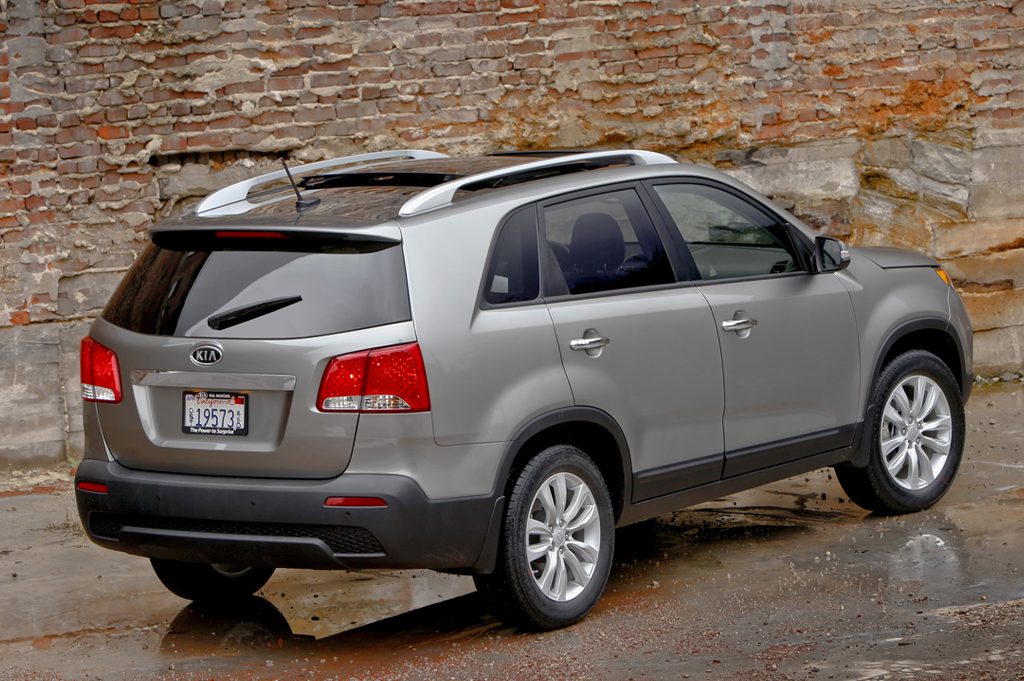| Midsize SUV; Built in USA |
|
|
| Good condition price range: $9,300 – $32,600* |

2011 Kia Sorento Front

2011 Kia Sorento Interior

2011 Kia Sorento Rear
| Pros: |
|
| Cons: |
|
Sorento’s transformation to a crossover SUV from a traditional truck-type design works to its benefit. In this form, Sorento rides and handles well, aided by tidy-for-the-class exterior dimensions. Many available upscale features add to its Best Buy 2011-13) appeal. Rear-seat room and comfort are a bit disappointing, and the available third row is merely a token gesture. Fortunately, the more potent four-cylinder engine in the latest Sorento is no slouch. If it’s enough for you, compared to the V6, a modestly equipped five-passenger Sorento may represent the best value in this lineup. Then again, better-equipped models may have appealing prices, too, on the used-vehicle market.
Overview
In addition to freshened styling and new features, the redesigned 2011 Kia Sorento adopted new engines and a different body structure. Kia’s midsize crossover SUV shared elements of its basic design with the Santa Fe produced by Kia’s corporate parent, Hyundai. The 2003-2009 Sorento had been a five-passenger SUV that used traditional truck-type construction. Now capable of seating up to seven, the new Sorento used unibody construction. Trim levels for the redone 2011 model included entry-level LX, uplevel EX, and sporty SX. The LX and EX models held a standard 175-horsepower, 2.4-liter four-cylinder engine. Available on those and standard on the SX was a 276-horsepower, 3.5-liter V6. All Sorentos could have either front-wheel drive or all-wheel drive. A six-speed automatic was the sole transmission. The Base trim level and six-speed manual transmission were discontinued. Maximum towing capacity was 3,500 pounds.
Standard safety features included all-disc antilock braking, traction control, an antiskid system, curtain side airbags that covered the first two seating rows, and front side airbags. Hill ascent/descent control also was standard. All four-cylinder models had standard five-passenger seating. Optional on four-cylinder models and standard on V6 versions was a third-row bench seat that increased capacity to seven. A Convenience Package for the LX included rear-obstacle detection, a rearview camera, and fog lights. A Premium Package for the EX included leather upholstery, heated front seats, rearview camera, and on V6 models, a panoramic sunroof. A Limited Package for the EX included a navigation system, uplevel audio system, and chrome wheels. DVD entertainment was optional on the EX V6, and versions so-equipped cannot be ordered with a sunroof. SX models had specific trim and a sport suspension. Many features that were optional on the EX were standard on the SX, including leather, heated front seats, navigation, and the rearview camera. Sorento’s main rivals included the Chevrolet Equinox, Honda Pilot, Mazda CX-9, and Toyota Highlander.
Yearly Updates
| 2012 Sorento A new Base trim level debuted on the 2012 Kia Sorento, and a new, more powerful (and thriftier) four-cylinder engine became available. The Base model got the existing 175-horsepower 2.4-liter engine. A new 191-horsepower Gasoline Direct Injection (GDI) version was standard in the LX GDI and EX GDI editions. Base and non-GDI LX models came only with front-drive; others could have either front-drive or all-wheel drive. A six-speed manual gearbox was standard on the new Base model; all others used a six-speed automatic. All four-cylinder Sorentos had standard five-passenger seating. A third-row bench seat was optional in LX and EX models, but standard with V6 power. |
| 2013 Sorento After seeing a number of additions and revisions for the 2012 model year, changes for 2013 were more subtle. Some features that had been standard on top-line models were now optional. You were also no longer required to purchase a 3rd-row seat in order to get a V6 engine. The entry-level Base model, which was around primarily for Kia to hit a particular price point, was dropped. |
